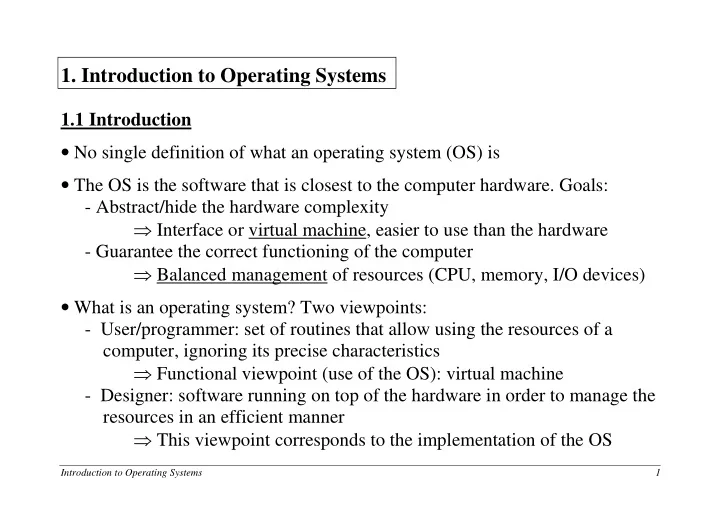

1. Introduction to Operating Systems 1.1 Introduction • No single definition of what an operating system (OS) is • The OS is the software that is closest to the computer hardware. Goals: - Abstract/hide the hardware complexity ⇒ Interface or virtual machine, easier to use than the hardware - Guarantee the correct functioning of the computer ⇒ Balanced management of resources (CPU, memory, I/O devices) • What is an operating system? Two viewpoints: - User/programmer: set of routines that allow using the resources of a computer, ignoring its precise characteristics ⇒ Functional viewpoint (use of the OS): virtual machine - Designer: software running on top of the hardware in order to manage the resources in an efficient manner ⇒ This viewpoint corresponds to the implementation of the OS Introduction to Operating Systems 1
1.2 Functional viewpoint of operating systems • Interfaces of an operating system: - System calls (OS primitives) - Command Interpreter: text oriented (command-line, shell), graphical… • System call interface (functions of the virtual machine): - Interface between applications and the OS (set of routines) - Source-code level compatibility among different computers User Application Application programs programmer Utilities OS Operating System designer Hardware Introduction to Operating Systems 2
1.3 Operating system functions • Program execution. Load instructions and data into main memory, initialize files and I/O devices, prepare other resources… • Access to Input/Output devices. Hide their complexity, allowing programs to do I/O operations in terms of simple reads and write instructions • Controlled access to files. Manage file formats and storing. Control concurrent accesses to files • Access to the system. Control the permission to enter the system. Control the permission to access the resources • Error detection and recovery. Detect both hardware and software errors. Actions: retry, finish program, warn… • Accounting. Measure the use of resources. Goals: detect new needs, improve efficiency, correct mistakes, billing… Introduction to Operating Systems 3
1.4 Evolution of operating systems • Batch systems: - First OS: monitor program, punch cards, operator. The monitor chained programs. The CPU was most of the time idle, waiting for I/O completion. In order to improve CPU usage, multiprogramming was developed • Time sharing systems: - Together with multiprogramming, in the 60s. Interactive systems, dumb terminals (no CPU, no memory, no disk), quantum . Goal: response time as short as possible • Teleprocessing systems: - Remote terminals (PCs nowadays), connected to the system via a proprietary protocol: reservation systems, banking transaction systems Introduction to Operating Systems 4
1.4 Evolution of operating systems (continued) • Personal systems (PCs, workstations): - 80s, hardware becomes cheaper. They were initially single-user and monoprogrammed (e.g., MS-DOS). Today they are multiprogrammed, with sophisticated graphical user interfaces. User = administrator • Networked systems: - computers are connected via a network protocol TCP/IP (public) vs. Novell, AppleTalk (proprietary) - each computer has its own OS - servers ↔ clients - types of networks: local ( Ethernet ), wide area ( Internet ) • Distributed systems: - resources/services of various machines are transparently integrated. Goals: resource sharing, improve efficiency, fault-tolerance… Introduction to Operating Systems 5
1.5 Classification of operating systems • Monoprogrammed / Multiprogrammed: Concurrent program execution ≡ processes → programs of a single user Multitasking Multiprocessing (many CPUs) → real parallel execution • Single terminal / multiterminal • Single user / multiuser: distinguish users • Proprietary / open source: related to a specific brand/company * Microcomputer OS → minicomputer OS → mainframe OS (old classification) * User friendly / not friendly: graphical interfaces A computer can host more than one OS (e.g., Windows and Linux in a PC). Also, there are OS emulators (e.g., Win4Lin , VMWare, VirtualPC… ) Introduction to Operating Systems 6
1.6 Examples and families 1.6.1. Unix: families and versions • 1970 Bell-Labs AT&T. C programming language. 1974 public version available • Unix families: Ultrix – Digital System V ATT Xenix – Microsoft BSD Univ. Berkeley: Sun (Solaris) AIX – IBM PCs – SCO, SantaCruz – Linux (RedHat, Debian, SuSe, Ubuntu…): www.linux.org • Multiprogrammed, multiuser, multiterminal. Text oriented command interpreters (shell, C-shell, K-shell...), also graphical (Openwin, Motif, KDE, Gnome...). Some versions support multiprocessing Introduction to Operating Systems 7
Introduction to Operating Systems 8
1.6.2. Microsoft: MS-DOS, Windows, Windows95/98/ME, WindowsNT/2000, WindowsXP… • 1980: IBM. Contract with Microsoft (1981) → MS-DOS • MS-DOS 1.0 (12 KB): Compatible with CP/M, better disk management, faster Single directory per floppy disk, limited to 64 files • MS-DOS 2.0: (1983, PC/XT) Hard disk, hierarchical directory system, Input/Output redirection (imported from Unix) • 1984 (PC/AT): Intel 80286 (extended address space, memory protection mechanisms). MS-DOS 3.0 (same as 2.0, 36 KB) 3.1 version: network support • 1990: Windows (not a real OS): graphical interface on top of MS-DOS, offering multitasking • 1995: Windows95, multitasking, memory protection, and 32 bit addressing. Windows98 and WindowsME as evolutions Windows NT (New Technology) → Windows 2000 → Windows XP → … Introduction to Operating Systems 9
Introduction to Operating Systems 10
1.6.3. IBM: MVS, AS/400, VM Mainframes. Proprietary OS • MVS: ↑ complex, ↑ big; teleprocessing applications, fast access to huge databases, security mechanisms • VM: virtual machine operating system • AS/400: similar to MVS, but for minicomputers • OS/2 (Warp): microcomputers (PCs) 1.6.4. Others: Macintosh, Digital, Google.... • MacOS: first graphical user interface. Proprietary system: only in Apple computers ↓ • Digital VMS: used heavily in academia (minicomputers) • Mach, Amoeba, Chorus: distributed operating systems • Real-time OS: Windows XP Embedded, QNX, RTLinux… • PDA, smartphone, tablet: iOS, Windows Phone, Palm OS, Symbian, Android Introduction to Operating Systems 11
Recommend
More recommend